Ralph Caspers is the host of two of the most well-known German children’s TV programs. He has been doing this for so long that everyone at Ulysses knows who he is: either because they watched his shows when they were younger or because they have children who watch them now.
Naturally, this is why we are particularly excited that Ralph is one of our users. We met with him in his hometown of Cologne and spoke with him about TV, writing, and working with Ulysses.
The original German version of this interview is available here.
You are well-known in Germany, but our blog readers are Ulysses users from all over the world. Could you please tell them a little bit about what you do?
I work for two of the most well-known children’s television shows in Germany: Die Sendung mit der Maus (“The Show with the Mouse”) that has been on the air for 49 years, and Wissen macht Ah! (“Knowledge makes you go Ah!”), that’s been around for 19 years. Both are educational programs for children, youth, and everyone else who is interested in learning. In addition to that, I write non-fiction books that deal with knowledge-related topics. In 2018, I wrote my first children’s book with bedtime stories, and in 2019 there was a part two. I also give concerts, for example the series Klassik macht Ah! (“Classical Music Makes You Go Ah!”), where we work in collaboration with the orchestra of the WDR broadcasting corporation: They play the music and we say a little something about Beethoven or Bach.
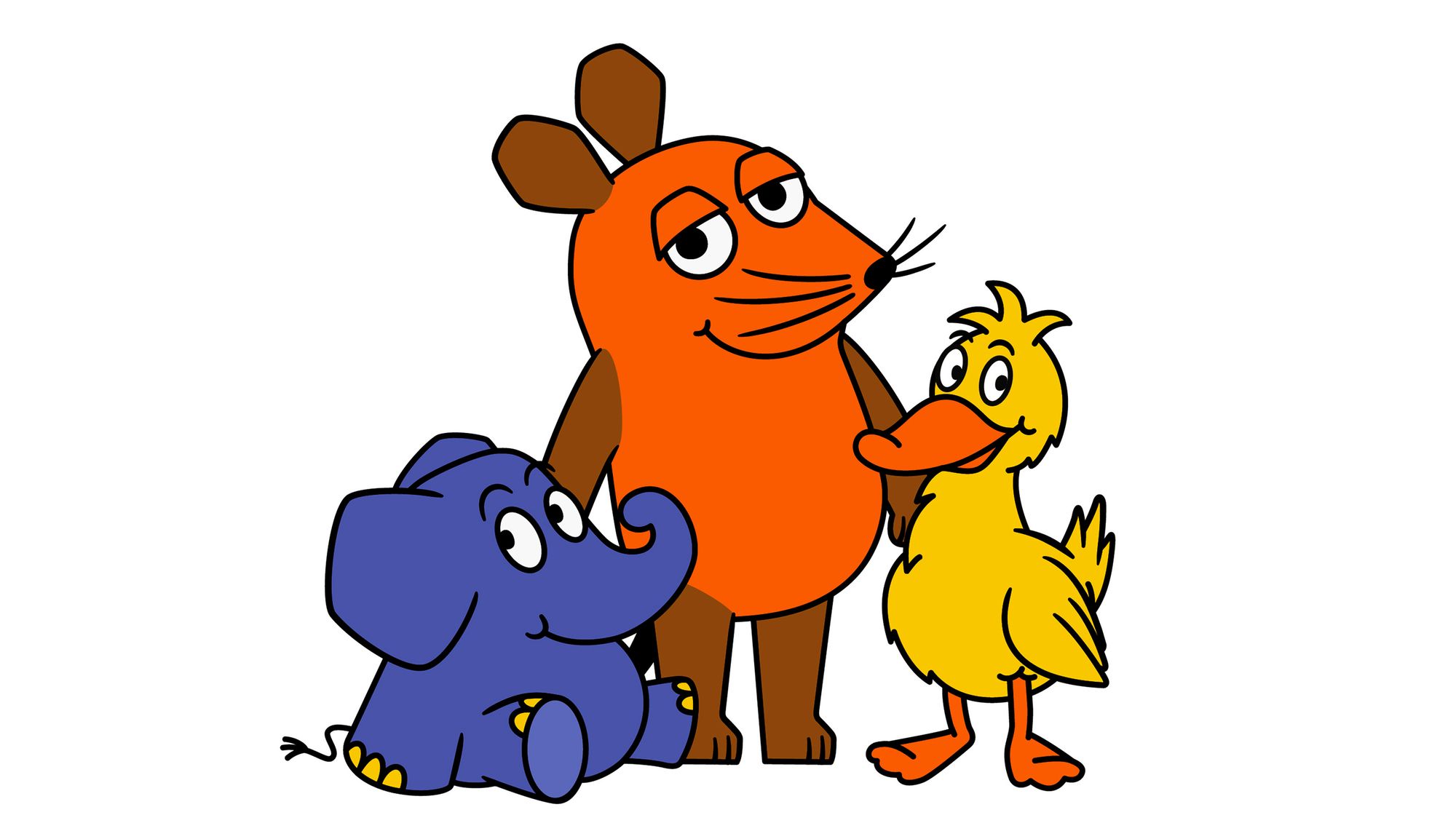
In your show Wissen macht Ah!, various, sometimes absurd, questions about knowledge-based topics are dealt with in short films. How do these questions come up?
Whenever you start asking questions about the way certain things work, it eventually becomes second nature. For example, one time I opened up an old flashlight and I saw that the batteries inside had leaked out fluid. Another question for Wissen macht Ah!: Why do batteries leak fluid? What is that fluid that is leaking out? Why can that device no longer be used afterwards? Once you start asking questions like that, you see these types of things everywhere. The questions we answer come from everyone who works at Wissen macht Ah!, and also, of course, from our viewers. Anyone who has anything to do with the show contributes to it.
Whenever you start asking questions about the way certain things work, it eventually becomes second nature.
Please explain how an episode is made.
We have a giant pot of questions. We choose five of these for an episode and distribute them to the authors who make the short films. I get the scripts and read in advance what will happen in the short films. Then I consider the sequence of the films and topics for the presentations and then research the information that is necessary for them. I create a running plan for the show for myself and write down everything that we are going to say, but also write down whatever props we will need, whether it be special costumes or makeup, certain music, or perhaps graphics, photos or film clips. Once I have finished doing that for a bunch of episodes, there is a production meeting where all of the individual working groups come together. We then go through each episode and discuss what everyone and their respective departments needs to acquire or build, e.g. the props, equipment, makeup and costumes. When everything is done, we go into the studio and record the presentations.
We don’t always do this chronologically; it mostly makes more sense to film these out of order. On the set we prepare everything from the lighting to the props. While this is going on, Clarissa and I go through the script. Then we do a few dress rehearsals and then we film the scene. When one presentation scene is finished we do the next. In every episode there are six presentation scenes, therefore the day goes by pretty fast. When the short films are finished and the presentation scenes are too, they will be put together in editing. After all that, the episode can be broadcast.
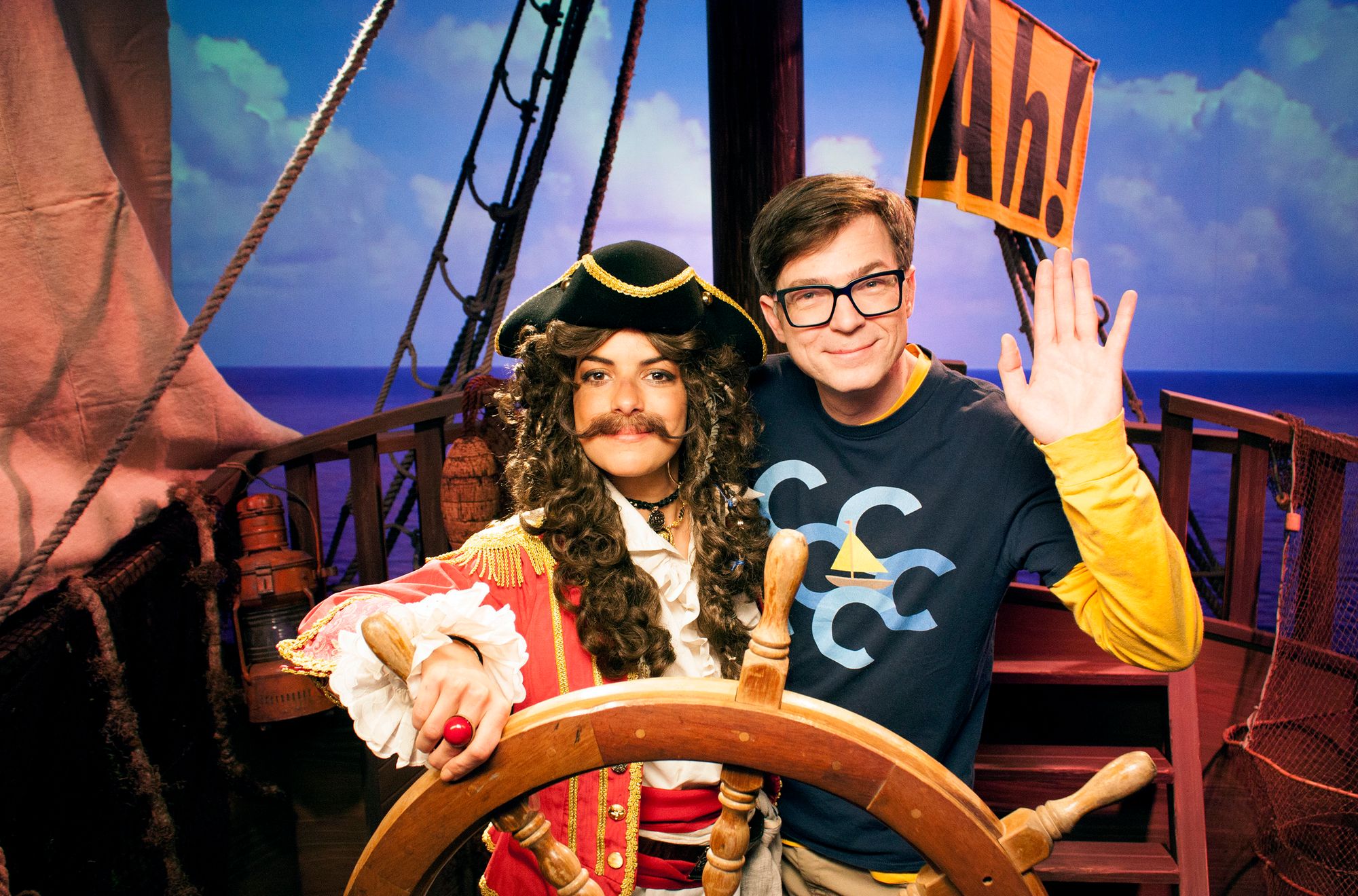
How did you come to work in television?
It’s actually really embarrassing. At some point my mother said to me, “You can’t live on my dime anymore, you need to get a job!”
Really?
Hm, Yes. She got me an internship; I started working on the show Geh aufs Ganze. That’s a game show; in English it’s called Let’s Make a Deal. I would come up with ideas for the games. The concept for the show is that people are taken from the audience and they can decide: Do you want what’s in this envelope or whatever’s in that box over there? If they decide to take what’s in the box, the host asks, “If you still would rather take what’s in the envelope, I’ll give you this small box, too.” You had to do deals like that. At the end of the show there were three doors and the final contestant had to pick one. Then the host said, “I’ll first show you what’s in Door Number 3.” Then you could decide whether to change your mind and take Door Number 1 or to stick with Door Number 2.
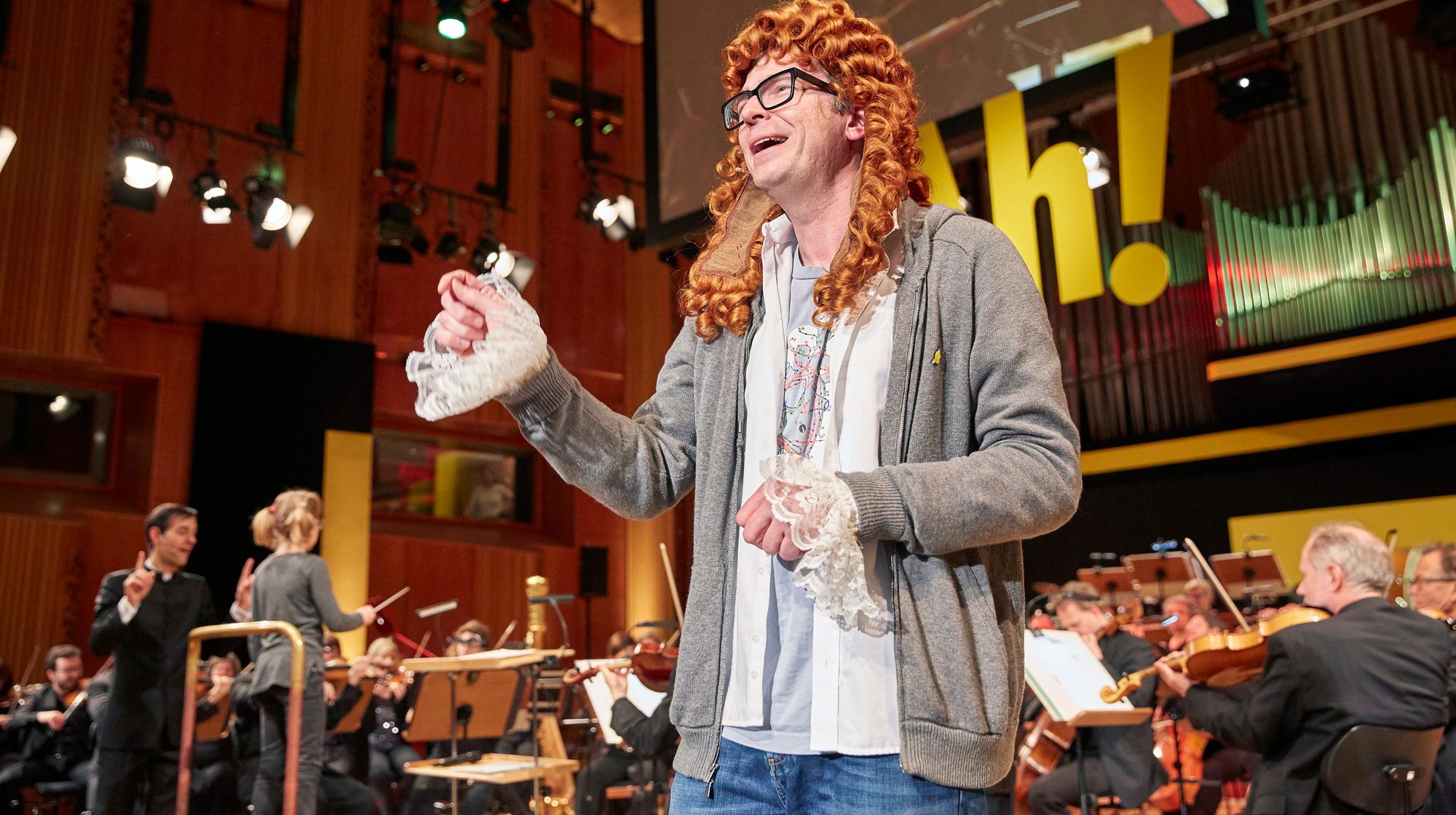
And always behind one of the doors was the “Zonk”
Exactly. That’s where I started. But by coincidence someone from the German network Super RTL saw me when I was on video, and this person thought, “Look! He would be good for one of those animal shows.” So in this way I fell further and further into this type of work. I didn’t really want it. Happenstance.
Naturally, it is difficult to emulate a happenstance, but if someone had the goal of becoming an author for TV for a show like Wissen macht Ah!, what advice would you give?
I would look at the closing credits of the shows I like to watch, to find out who produces it. Then I would apply there. Maybe start with an internship. That approach is often more promising than applying directly at the network. A broadcast network is gigantic, and it can take a long time before you can do what you like.
I think, if someone wants to write, the most important thing is: just write. Get started. Don’t wait until someone asks you to. Just do it.
I think, if someone wants to write, the most important thing is: just write.
But is it really that simple? Sure, someone can just start writing a novel these days and be able to self publish it, but if they want to write for a TV show, they need a show to do it.
When I started, that was the case for sure, but now there is YouTube. These days you can make your own shows. Clearly, you don’t automatically reach the same audience as a TV program, but all in all it is much easier to get started than it was 20 years ago.
When did you yourself start writing?
That started on the animal show on Super RTL, because I had to write my own hosting presentations. There wasn’t anyone to do it for me. After that it got to be more and more. There were more shows to do, scripts to write for the factual stories, and then the first show-related non-fiction book. That was the first time I had ever written anything that was printed. More non-fiction books followed. Everything sort of just developed over time.
How big a role does writing currently play in your life?
I write almost every day. They are not always proper texts; it depends on the project. They could be hosting presentations or ideas that I put down on paper. Of course, whenever I have a book project like the bedtime stories, it’s much more intense. For that I think it’s nice when I can concentrate on one task for many hours, not like writing hosting presentations where I have to do many things all at the same time.
So writing hosting presentations is different?
Whenever I work on hosting presentations questions come up very often, like how a thing works. Then I have to stop writing and do some research or make a phone call. I might have to wait until someone with the answers calls me back. It is much more piecemeal work. When I write stories, I can simply sit down and get to work and see how far I get.
Please tell us some more about your books.
The last two were bedtime stories, i.e. short stories for going to sleep. In both books there is the same cast of characters: a young girl, her little brother, her family and her friends, who all live in the same street. They experience things that start very real but often drift into the impossible. These came about because I myself had to read stories to my kids. I got a little bored after about fifty readings of “Conni Is Starting Kindergarten”. One time I simply told my daughter what happened to her on that day and exaggerated it a bit. That kind of continued and suddenly I had a whole lot of stories in my head.
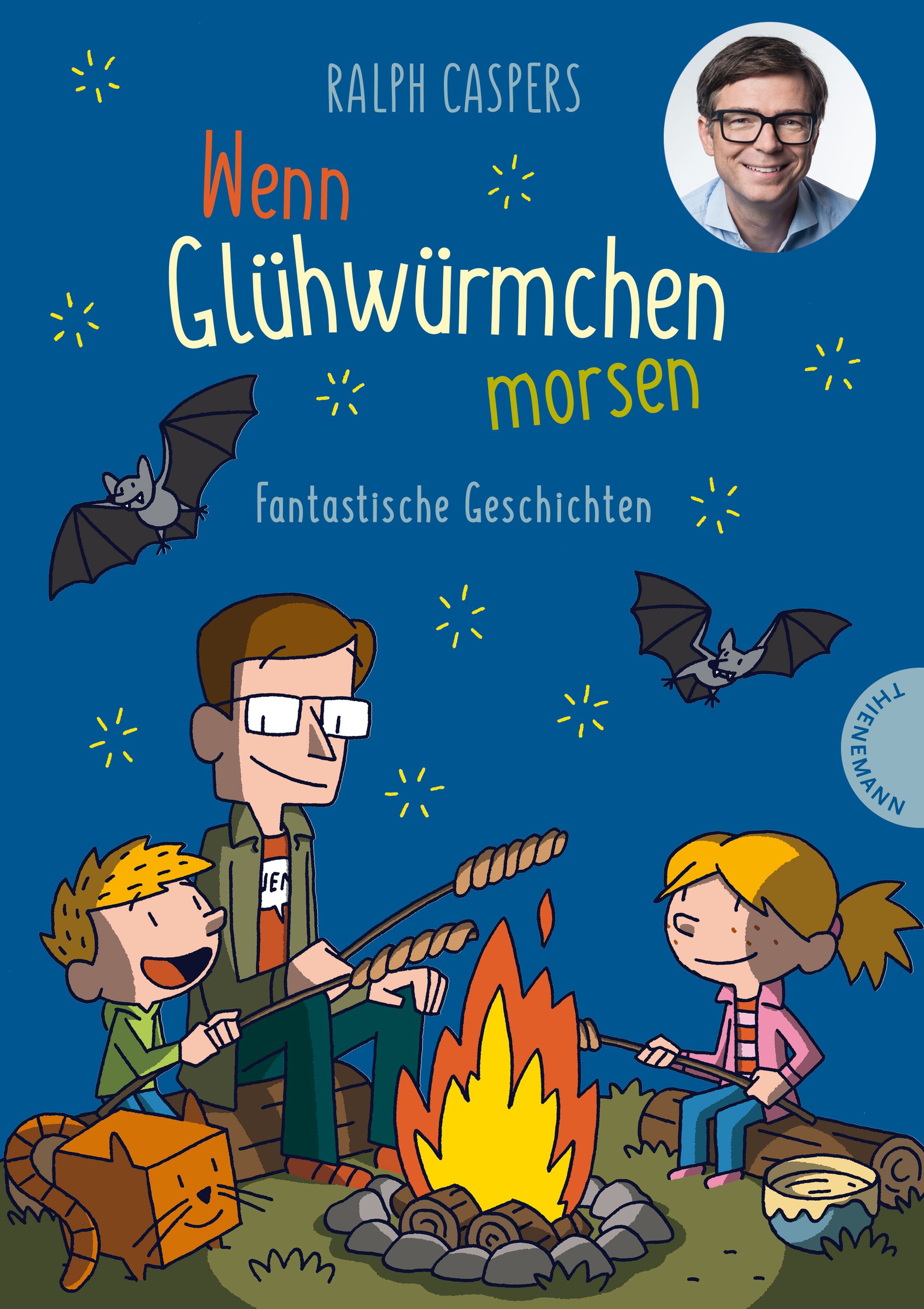
Around the same time I had always wanted to create a picture book, so I pitched the story to a few different publishers. One of the publishers wasn’t interested in making a picture book, but asked if I had other similar stories for a normal story book. I kind of snootily answered, that of course I have many, many stories. Then I had to write down everything I, up until that point, had just told orally. That was much more difficult than I had thought, but I had a great time doing it. The first book, Wenn Glühwürmchen morsen (“When Fireflies Send Morse Code”) came out in 2018 and shortly thereafter I wrote the second book, Wenn Riesen reisen (“When Giants Go on Holiday”).
And are you out of stories or are there any more?
There are many, many more. That’s the cool thing: Whenever you start, the brain keeps working automatically on more.
Were you an imaginative child?
I don’t know, you’d have to ask my parents. I think all in all, I was more of a normal kid who didn’t really stand out.
But now the stories simply come to you?
Yes. I don’t have writer’s block. If the story stalls because I can’t think of anything, then I do something else. It gets worked out in the back of my mind and at some point there is a “bing” and the problem is solved.
I don’t have writer’s block. When I can’t think of anything, I use whatever I can’t think of.
So you’ve never had writer’s block?
No, never. When I can’t think of anything, I use whatever I can’t think of. In one episode of Wissen macht Ah! I was pretending it was the first time I had ever written an episode of my own show. That went exactly as one could have predicted: I started over and over again to type something on an old typewriter and always threw the paper away. What I had typed, was automatically recorded as my hosting presentation. That was funny.
Do you have a typical daily routine?
When we are filming, I get up in the morning and drive to the studio. I get my make-up, then we do the presentations, then I take off my make-up and drive home. It is a relatively clear structure. When I write, I get up, sit down at my desk, and try, as well as I can, to work disciplined. But, I am not very disciplined. I really like to zone out.
I always try to structure my daily routine, but it doesn’t work. The dog needs to go out or the kids come and ask questions. When I am at the office, I have a bit more peace, but I get phone calls and there is always something. If I am nearing the end or close to a deadline it helps me to break away and go offline. For that I like to go to libraries where you really have to be quiet. That helps me concentrate.
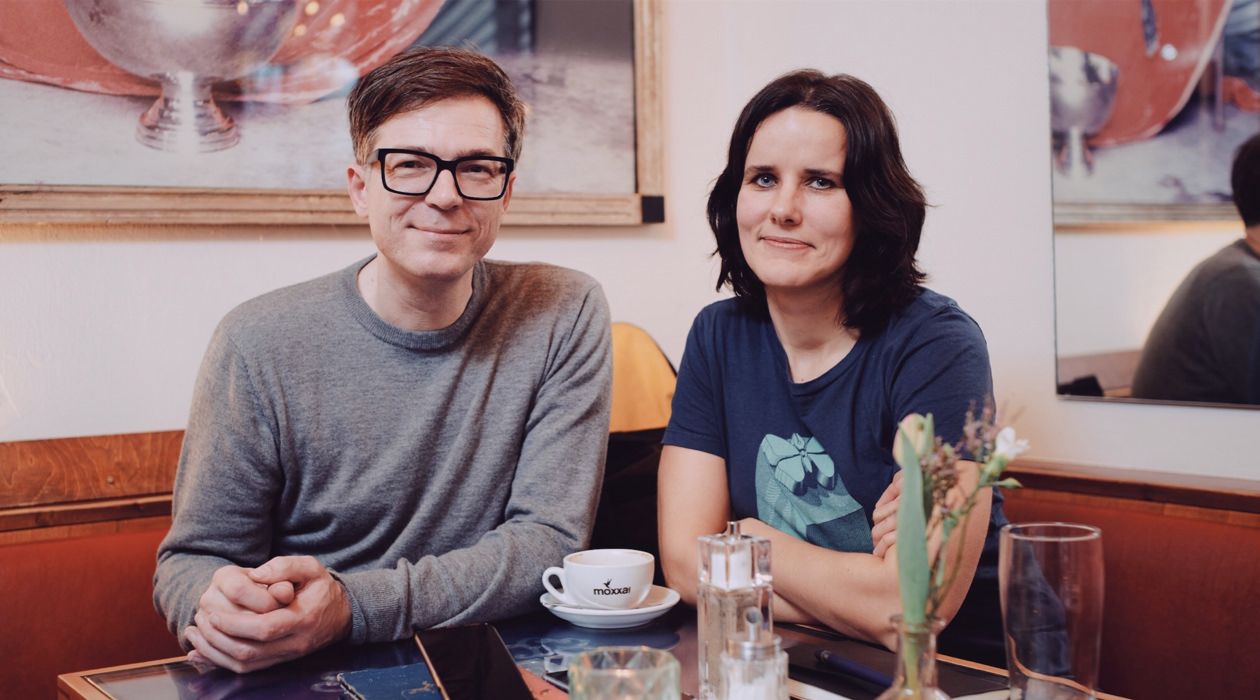
Where do you write?
Everywhere. That is the cool thing about Ulysses, that I have it on all my devices. If, for example, I have a good idea for a story, I dictate it for myself. Then I have a small sound file, that I can link to Ulysses, or I copy the transcription into Ulysses. I can revise and make changes on the iPad when I am on the go, or I can write it on the computer and I know that everything is synchronized to the same place. That makes it totally easy, because I don’t ever have to be at one specific place, but rather can work anywhere. That’s really great.
Please tell us more about how you use Ulysses.
For every episode I need at least four documents: The production table, my hosting presentation text, a document with the necessary props, costumes, etc., and a shooting plan. When one time changes in a report, I have to essentially change four documents and print them out again. In the past, when I started at Wissen macht Ah! that was too much work for me. For this reason, I made a database with Filemaker and everyone thought, “Wow, he can sure do a lot!” But it was only four layouts with the same data and only one button push. The problem with Filemaker is that you can’t make changes to it everywhere, and for some things it is overkill.
However, with Ulysses I can do the same thing, that’s why I have made layouts for it. For example for Klassik macht Ah!: I can write my text and hand it out as a normal manuscript with highlighting for what I say, what Clarissa says and with the director’s notes in red. The same thing can be done as a running plan for the orchestra withoutthe host’s scripts and can be printed out as charts for the performance in a much bigger size. I’ve only written it one time, but can distribute it immediately.
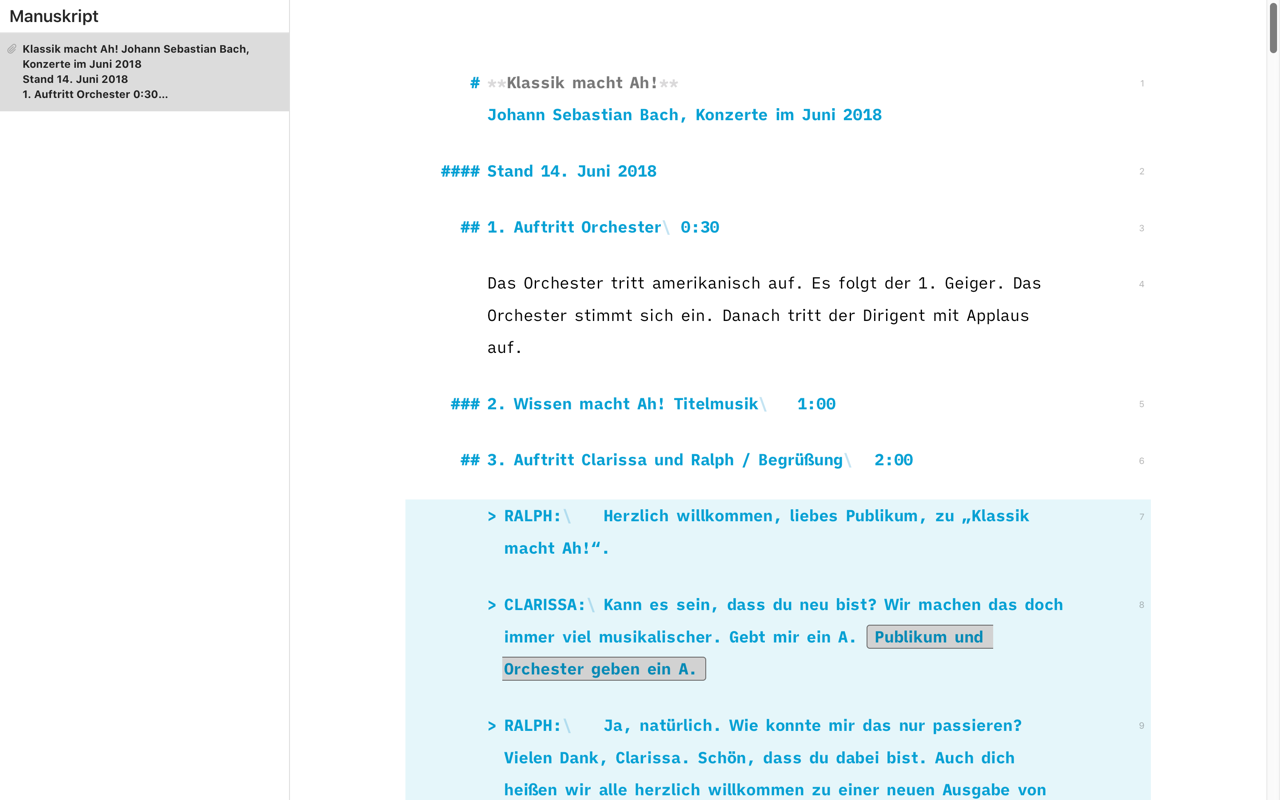

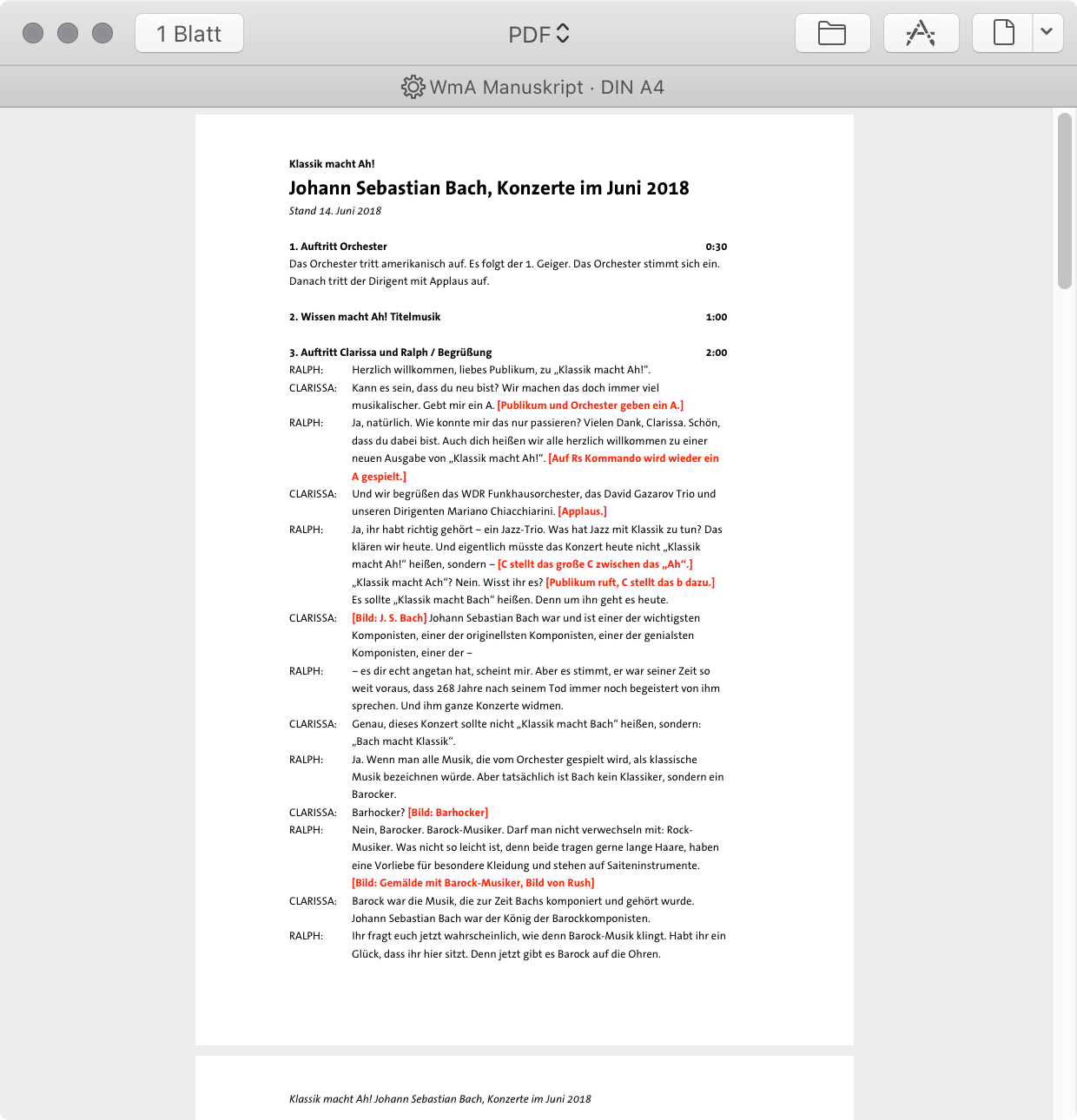
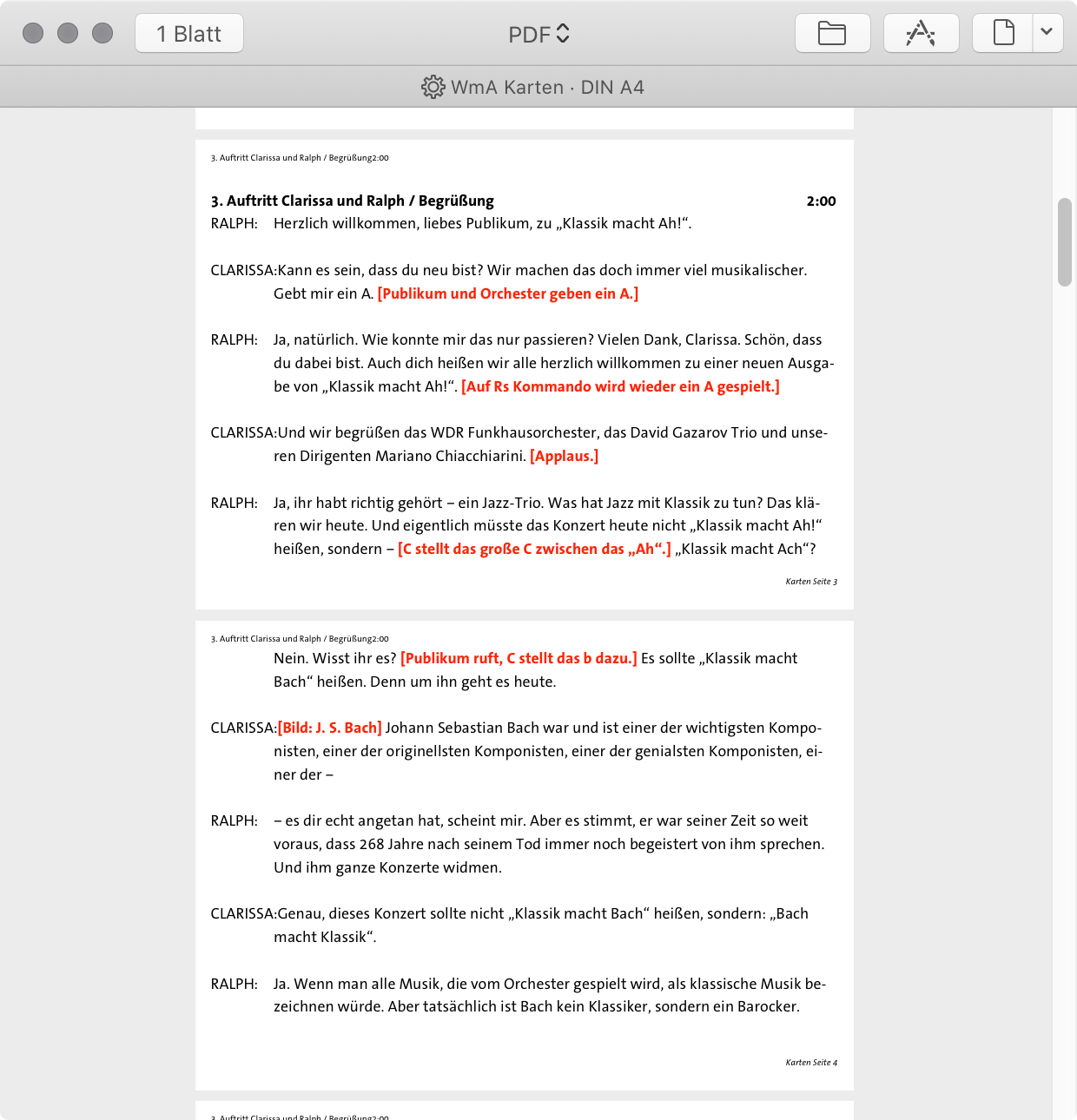
It’s also great that every document in Ulysses has its own link. I really like to work analog and was always disappointed that I couldn’t link Ulysses to my pocket notebook. Like, if I was finished with making notes and wanted to continue working in Ulysses, I would have loved a clickable link in my paper notebook taking me directly to my sheet in Ulysses. The same applies for my research in DevonThink. Then came the iOS version that could generate QR codes over Shortcuts. Since then I print my links out as QR codes, paste them in my notebook and then, by way of the camera, open my documents directly from the paper. Nerd alert.
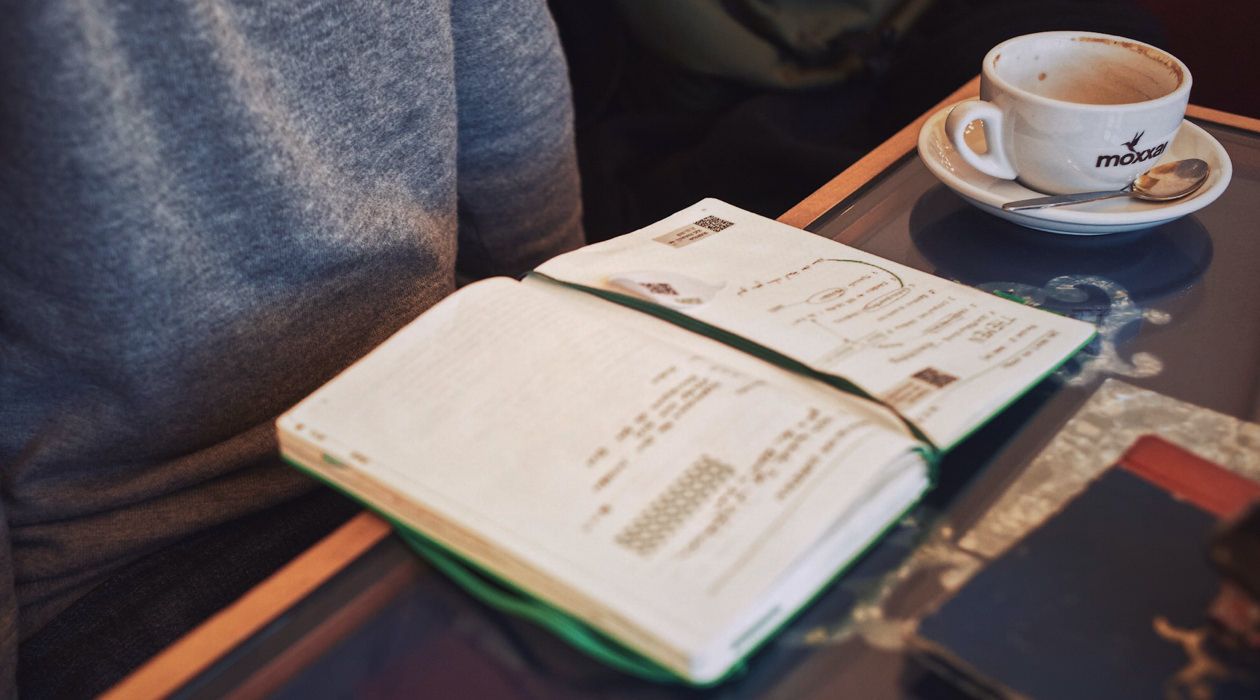
That is fairly elaborate.
That is a part of zoning out. When I procrastinate these kinds of things come out of it.
Do you have another favorite feature?
I like that it is so clean. I also notice it when I really have to concentrate on writing. I think it’s great that Ulysses doesn’t get in the way. That is very valuable.
Do you use writing goals or keywords?
Yeah, I use writing goals, so I don’t lose my overview. For my next book, I know that no chapter can be longer than 1670 characters. For example I use keywords when I want to follow which chapters are finished, which ones are being revised, and which ones I still need to work on.
What would you like to see in Ulysses?
It would be nice if there were a layout editor and separately-definable headers and footers. It would also be nice if it were easier to incorporate comments from proofreaders.
Which other apps help you be productive?
Mostly I just start with Just Press Record. That’s a small app that you use to record things and also directly transcribe them. Whenever I have an idea I record it into the app, then it’s transcribed more or less successfully into text, and then I can transfer this directly, to Ulysses for example. I also really like to use DevonThink, I keep all of my research there. I also use KeyboardMaestro on the Mac, to automate standard things. There’s nothing you can’t do with it. For example with KeyboardMaestro I can automatically let it enter a sort of summary at the end of the text with the current date, the number of characters, how long the host presentation is. If I have to think about which aspects of a topic are interesting, I often use MindNode.
Thank you very much for speaking with us and answering all of our questions.
Thank you very much. I think it’s cool that Ulysses exists. It makes my life much easier and simpler.
Do you want to link your physical notebook to a Ulysses sheet with a QR code like Ralph Caspers? Here’s how!
First, install Apple’s Shortcuts app on your iOS device.
Download Ralph’s shortcut. (You may have to change your the settings of the Shortcut’s app to “Allow Untrusted Sources”)
Now, whenever you want to create a QR code for a Ulysses sheet, follow these steps:
- Open Ulysses and switch to the sheetlist.
- Swipe left on the sheet in question, select the ellipsis icon and tap “Share…”
- Select “Copy Callback URL”.
- Switch to the Shortcuts app and run Ralph’s shortcut.
Voilá!
